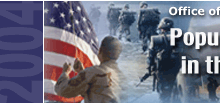


 |
 |
 |
|
|
INTRODUCTION Fiscal Year 2004: Youth Opportunities and Military Recruiting As one of the largest employers in our nation, the Armed Services offer entry-level positions with paid training and numerous benefits. In FY 2004, nearly 176,000 non-prior service (NPS) applicants were accepted into the enlisted ranks and over 19,000 new officers joined the officer corps of the Active Components. In addition, about 66,500 NPS enlistees and officers began serving their country in the Selected Reserve during FY 2004. That’s over 261,000 job openings annually. At the close of FY 2004, the Total Force stood at just under 1.4 million active duty members and just over 841,000 Selected Reservists. (Data for the past half century are shown in Figure 1.1, with some projections for the future.)
Figure 1.1. The population of 18-year-old males and Active Component non-prior service (NPS) recruiting requirements for fiscal years 1950–2010 (projected). Obviously, the decision to enlist in the military is a milestone in any young person’s life. And this decision is influenced by a variety of factors. For those who choose to or must immediately enter the workforce, the prevailing economic conditions may come into play. Over the past decade, the unemployment rate for 16-19 year olds has ranged from 13% to 17%, compared to between 3% and 5% for 25-54 year olds. Given this relatively high rate, the military’s ability to offer job security and good pay and benefits should make it an attractive option to many youth whose civilian options are limited. Members of the Services receive training and work experience in a multitude of occupational specialties—from infantry and maintenance to medicine and administration. Servicemembers manage, operate, maintain, and coordinate the use of complicated weapon systems gaining critical technical and leadership experience as they progress through the ranks. Given the technical nature of many military jobs, and the relatively steep learning curve in all occupations, the military services must be concerned, not just with the sheer numbers of recruits obtained each year, but also with their quality. This is primarily measured through educational attainment and performance on the military entrance test—the Armed Services Vocational Aptitude Battery (ASVAB). A "high quality" recruit is defined as an individual who has obtained a traditional high school diploma and who scores at or above the 50th percentile on the Armed Forces Qualification Test—a combination of several ASVAB subtests. In recent years the services have done well in recruiting such youth, with an overall increase of high quality accessions of 10% between 2001 and 2004 (from 57% to 67%). In part this reflects that fact that 92% of accessions in 2004 were high school graduates (7% held alternative degrees, and less than 1% were nongraduates). Since the advent of the All Volunteer Force in 1973, a primary challenge faced by military recruiting has been the increase in youth participation in post-secondary education. In 1973, 33% of 18-19 year old males were enrolled in higher education. In 2003 this figure stood at 47%. [Footnote 1] Further, a majority of high school graduates make the transition immediately to post-secondary educational pursuits (61% of males, 66% of females in 2003). Between 1972 and 2003, the rate of immediate progression for high school completers rose from 49% to 64%, although it has been relatively stable at the latter figure since 1998. [Footnote 2] Recent attempts to tap the market of college-bound youth have met with limited success, and the percentage of enlistments that enter the military after college has historically been low. However, the desire for higher education has also worked for military recruiting. Educational benefits are a major inducement for many individuals, and typically are the reason for enlisting cited by the largest percentage of new recruits. [Footnote 3] Furthermore, the services have made efforts to make it possible for members to work towards their civilian education goals while in the military. One example of this is the Army’s well-received eArmyU program, in which Soldiers can obtain post-secondary credits for courses taken largely online. This medium opens up possibilities for a population that is often constrained in their educational pursuits by their mobility due to permanent change of station moves and deployments. Clearly the "typical" recruiting environment, which is influenced by economic factors, the desires of youth, and the options available to them, also was potentially affected in 2004 by the war in Iraq and other mobilizations. A 2004 survey of American youth found that fear (e.g., death/injury, being in combat) was cited by 26 percent of respondents as a reason to not enlist in the military. [Footnote 4] This was almost double the proportion selecting this reason (14 percent) in a study conducted in 2000. The same 2004 survey found that 57 percent of youth selected the risk of being called to active duty as a barrier to joining the Reserves, while only 32 percent responded in this fashion in 2000. Finally, 2005 DoD Youth and Influencer Poll data indicate that 62% of those interviewed said that the war on terrorism made them less likely to enlist in the military. [Footnote 5] Other data point to a potential differential impact of world events on the propensity of youth to enlist. In general with respect to race/ethnicity, the Armed Forces maintain a fairly representative workforce. Blacks continue their historically strong military presence in the enlisted ranks (21 percent), at levels higher than population proportions (12 percent). Black accessions, however, more closely mirror the population at 15 percent. This represents a downturn in Black accessions, which comprised 20 percent of all NPS enlisted accessions in FY 2001. Although causality cannot be ascribed, it is of interest that the aforementioned 2005 Youth Poll found that while 62% of Whites interviewed supported U.S. troops being in Iraq, only 54% of Hispanics and 40% of Blacks held this view. Blacks have achieved representation parity in the officer corps. Hispanics remain somewhat underrepresented but are making gains within the enlisted ranks and officer corps. Hispanic representation is important to monitor in light of increasing Hispanic population proportions and related issues of citizenship, English language proficiency, and high school graduation rates. Unlike racial and ethnic minorities, the role of women in the military is still unsettled if not controversial. Although women comprise half of the youth population, in FY 2004, they made up only 16.5 and 21 percent of enlisted and officer accessions, respectively. However, these figures are close to all-time highs in the representation of women entering the military. In 1964, before the All Volunteer Force, less than 1 percent of enlisted accessions were women. This proportion climbed to 5 percent in 1973 and shortly thereafter, topped 10 percent. Today, that figure has almost doubled, even in the face of a more streamlined force. Although much progress has been achieved with regard to gender equity, much work remains. The representation of women has increased and many previously closed positions have been opened to women. The military continues to consider current and future roles for women in uniform. [Footnote 1] National Center For Education Statistics (2004). Digest of Education Statistics, 2004 (NCES 2006-0005). Washington, DC: U.S. Department of Education. [back to paragraph] [Footnote 2] National Center for Education Statistics (2005). The Condition of Education 2005, Indicator 20, Immediate Transition to College (NCES 2005-094). Washington, DC: U.S. Department of Education. [back to paragraph] [Footnote 3] U.S. Army Research Institute (December 2002). Survey report, Sample Survey of Military Personnel: Reasons for joining the Army (Report No. 2003-02). Arlington, VA: U.S. Army Research Institute for the Behavioral and Social Sciences. [back to paragraph] [Footnote 4] G.f.K. Custom Research, Inc. U.S. Military Image Study. Retrieved from http://dccw.hqda.pentagon.mil/downloads/Army/ArmyEquityStudyConDeck1.pdf. [back to paragraph] [Footnote 5] Joint Advertising, Market Research and Studies (2005). Department of Defense June 2005 Youth Poll briefing. Retrieved from http://www.dmren.org/DMREN/execute/secure/home [back to paragraph]
Summary
| Contents | Search
| Download | Links
| FAQ | Home
|